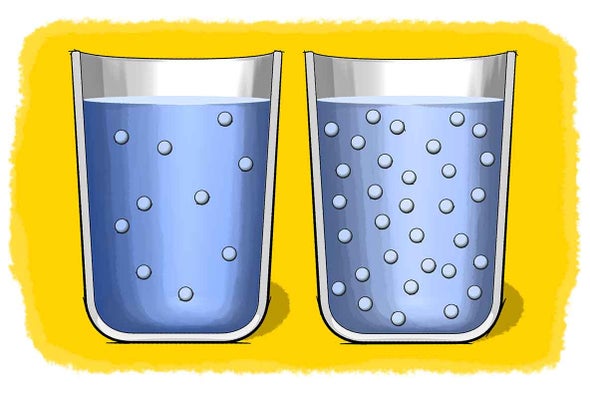 Key conceptsChemistry
Key conceptsChemistry
Property of matter
Solutions
SolubilityIntroduction
Have you ever added a spoon of sugar to your tea and wondered why it disappeared? Where did it go? The sugar did not actually disappear—it changed from its solid form into a dissolved form in a process called chemical dissolution. The result is a tea–sugar solution in which individual sugar molecules become uniformly distributed in the tea. But what happens if you increase the amount of sugar that you add to your tea? Does it still dissolve? In this activity you will find out how much of a compound is too much to dissolve.Materials- Distilled water
- Measuring cup that measures milliliters
- Eight glasses or cups that each hold eight ounces
- Four spoons
- Measuring spoon
- Epsom salts (150 grams)
- Table salt (50 grams)
- Table sugar (cane sugar, 250 grams)
- Baking soda (20 grams)
- Scale that measures grams
- Marker
- Masking tape
- Paper
- Pen
- Thermometer (optional)
Preparation
- Using the marker and masking tape label two cups for each compound: “table salt,” “table sugar,” “baking soda” and “Epsom salts.”
- Into one table salt cup measure 50 grams of salt.
- Into one table sugar cup measure 250 grams of sugar.
- Into one baking soda cup measure 20 grams of baking soda.
- Into one Epsom salts cup measure 150 grams of Epsom salts.
- For each cup weigh it and write down the mass (weight).
- Add 100 milliliters of distilled water into each cup. Use the measuring cup to make sure each cup has the same amount of water. The water should be at room temperature and the same for all cups. You can use a thermometer to verify that.
- Take both of the cups you labeled with table salt. With the measuring spoon carefully add one teaspoon of table salt to the 100 milliliters of distilled water.
- Stir with a clean spoon until all the salt has dissolved. What do you notice when you add the salt to the water?
- Keep adding one teaspoon of salt to the water and stirring each time, until the salt does not dissolve anymore. What happens when the salt does not dissolve anymore?
- Repeat these steps with both cups labeled Epsom salts. At what point does the Epsom salts solution become saturated?
- Repeat the steps with the baking soda. How many teaspoons of baking soda can you dissolve in the water?
- Repeat the steps with the sugar. Did you add more or less sugar compared with the other compounds?
- Put each of the cups containing the remaining solids onto the scale and write down the mass (weight) of each one. How much of each substance did you use?
- Subtract the measured mass from your initial mass (see Preparation) for each compound. What does the difference in mass tell you about the solubilities of each of the compounds? Which compound is the most or least soluble in distilled water?
- Extra: Does the solubility change if you use a different solvent?Repeat the test, but instead of using distilled water use rubbing alcohol, vegetable oil or nail polish remover as solvent. How does this change your results?
- Extra: Can you find other substances or chemicals that you can dissolve in distilled water? How do their solubilities compare with the compounds you have tested?
- Extra: Solubility of compounds is also highly dependent on the temperature of the solvent. Do you think you can dissolve more salt or sugar in hot or cold water? Test it to find out!
Observations and results
Did all of your tested compounds dissolve in distilled water? They should have—but to different extents. Water in general is a very good solvent and is able to dissolve lots of different compounds. This is because it can interact with a lot of different molecules. You should have noticed sugar had the highest solubility of all your tested compounds (about 200 grams per 100 milliliters of water) followed by Epsom salts (about 115 grams/100 milliliters) table salt (about 35 grams/100 milliliters) and baking soda (almost 10 grams/100 milliliters).
Did all of your tested compounds dissolve in distilled water? They should have—but to different extents. Water in general is a very good solvent and is able to dissolve lots of different compounds. This is because it can interact with a lot of different molecules. You should have noticed sugar had the highest solubility of all your tested compounds (about 200 grams per 100 milliliters of water) followed by Epsom salts (about 115 grams/100 milliliters) table salt (about 35 grams/100 milliliters) and baking soda (almost 10 grams/100 milliliters).
This is because each of these compounds has different chemical and physical properties based on their different molecular structures. They are all made of different chemical elements and have been formed by different types of bonds. Depending on this structure it is more or less difficult for the water molecules to break these bonds and form new ones with the solute molecules in order to dissolve them into a solution.


No comments:
Post a Comment